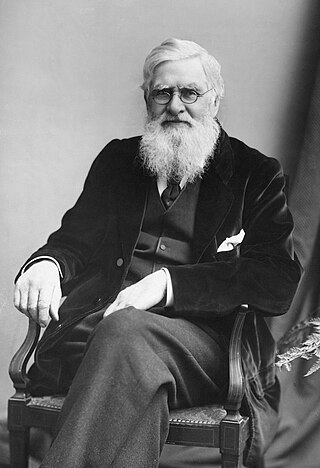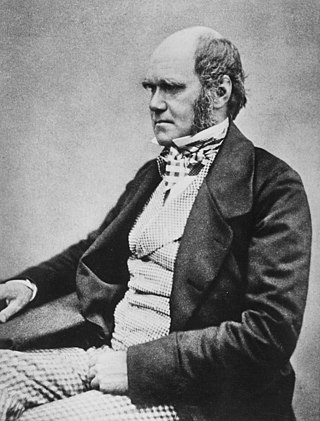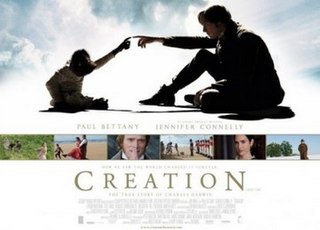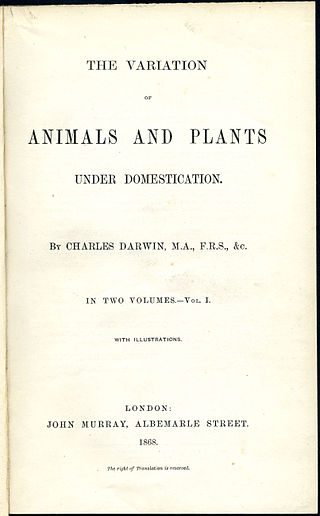
Alfred Russel Wallace was an English naturalist, explorer, geographer, anthropologist, biologist and illustrator. He independently conceived the theory of evolution through natural selection; his 1858 paper on the subject was published that year alongside extracts from Charles Darwin's earlier writings on the topic. It spurred Darwin to set aside the "big species book" he was drafting and to quickly write an abstract of it, which was published in 1859 as On the Origin of Species.

Darwinism is a term used to describe a theory of biological evolution developed by the English naturalist Charles Darwin (1809–1882) and others. The theory states that all species of organisms arise and develop through the natural selection of small, inherited variations that increase the individual's ability to compete, survive, and reproduce. Also called Darwinian theory, it originally included the broad concepts of transmutation of species or of evolution which gained general scientific acceptance after Darwin published On the Origin of Species in 1859, including concepts which predated Darwin's theories. English biologist Thomas Henry Huxley coined the term Darwinism in April 1860.

On the Origin of Species is a work of scientific literature by Charles Darwin that is considered to be the foundation of evolutionary biology. It was published on 24 November 1859. Darwin's book introduced the scientific theory that populations evolve over the course of generations through a process of natural selection, although Lamarckism was also included as a mechanism of lesser importance. The book presented a body of evidence that the diversity of life arose by common descent through a branching pattern of evolution. Darwin included evidence that he had collected on the Beagle expedition in the 1830s and his subsequent findings from research, correspondence, and experimentation.

Sir Francis Darwin was a British botanist. He was the third son of the naturalist and scientist Charles Darwin.

The Darwin–Wedgwood family are members of two connected families, each noted for particular prominent 18th-century figures: Erasmus Darwin, a physician and natural philosopher, and Josiah Wedgwood FRS, a noted potter and founder of the eponymous Josiah Wedgwood & Sons pottery company. The Darwin and Wedgwood families were on friendly terms for much of their history and members intermarried, notably Charles Darwin, who married Emma Wedgwood.
"On the Tendency of Species to form Varieties; and on the Perpetuation of Varieties and Species by Natural Means of Selection" is the title of a journal article, comprising and resulting from the joint presentation of two scientific papers to the Linnean Society of London on 1 July 1858: On The Tendency of Varieties to Depart Indefinitely from the Original Type by Alfred Russel Wallace and an Extract from an unpublished Work on Species from Charles Darwin's Essay of 1844. The article also includes an Abstract of a Letter from Darwin to Asa Gray, and an introductory letter by Joseph Dalton Hooker and Charles Lyell. The article was the first announcement of the Darwin–Wallace theory of evolution by natural selection; and appeared in print on 20 August 1858. The presentation of the papers spurred Darwin to write a condensed "abstract" of his "big book", Natural Selection. This was published in November 1859 as On the Origin of Species.

The publication of Darwin's theory brought into the open Charles Darwin's theory of evolution through natural selection, the culmination of more than twenty years of work.
Between 1860 and 1868, the life and work of Charles Darwinfrom Orchids to Variation continued with research and experimentation on evolution, carrying out tedious work to provide evidence of the extent of natural variation enabling artificial selection. He was repeatedly held up by his illness, and continued to find relaxation and interest in the study of plants. His studies of insect pollination led to publication of his book Fertilisation of Orchids as his first detailed demonstration of the power of natural selection, explaining the complex ecological relationships and making testable predictions. As his health declined, he lay on his sickbed in a room filled with inventive experiments to trace the movements of climbing plants.

The British naturalist Charles Darwin corresponded with his extended family and with an extraordinarily wide range of people from all over the world. The letters, over 15,000 in all, provide many insights on issues ranging from the origins of key scientific concepts, to religious and philosophical discussions which have continued to the present day. The letters also illuminate many aspects of Darwin and his biography: the development of his ideas; insights into character and health; and private opinions on controversial issues. His letters to the Harvard botanist Asa Gray, for example, show his opinions on slavery and the American Civil War. Darwin relied upon correspondence for much of his scientific work, and also used letters to marshal support for his ideas amongst friends and colleagues. The historian of science Janet Browne has argued that Darwin's ability to correspond daily played a crucial role in the development of his theory and his ability to garner support for it from colleagues.
Between 1868 and 1872, the life and work of Charles Darwinfrom Descent of Man to Emotions continued with aspects of his intended "Big Book" on evolution through natural selection. He had by then hurriedly published an "abstract" of this work as On the Origin of Species in 1859, and following the immediate reaction to Darwin's theory his earlier work included demonstrating the utility of the flowers of Orchids in directing insect pollination to achieve cross fertilisation, and a summing up of thirteen years of experiments in The Variation of Animals and Plants Under Domestication which went on sale on 30 January 1868. He now published his ideas on human evolution and on how beautiful but apparently impractical features could have evolved in The Descent of Man, and Selection in Relation to Sex. After revising The Origin of Species as the definitive 6th edition, his major works on species culminated in The Expression of the Emotions in Man and Animals. This period was followed by extensive work on insectivorous plants and research into worms.
Between 1873 and 1882, the life and work of Charles Darwin from Insectivorous Plants to Worms continued with investigations into carnivorous and climbing plants that had begun with his previous work. Worries about family illnesses contributed to his interest in Galton's ideas of "hereditary improvement". He continued to help with the work of Downe parish church and associated village amenities, despite problems with control being seized by a new High Church vicar, and he remained on good terms with the Church's patron, the Revd. John Brodie Innes. There was continuing interest in Charles Darwin's views on religion, but he remained reticent.

Elizabeth Janet Browne is a British historian of science, known especially for her work on the history of 19th-century biology. She taught at the Wellcome Trust Centre for the History of Medicine, University College, London, before returning to Harvard. She is currently Aramont Professor of the History of Science at Harvard University.

Hensleigh Wedgwood was a British etymologist, philologist and barrister, author of A Dictionary of English Etymology. He was a cousin of Charles Darwin, whom his sister Emma married in 1839.

Charles Robert Darwin was an English naturalist, geologist, and biologist, widely known for his contributions to evolutionary biology. His proposition that all species of life have descended from a common ancestor is now generally accepted and considered a fundamental scientific concept. In a joint presentation with Alfred Russel Wallace, he introduced his scientific theory that this branching pattern of evolution resulted from a process he called natural selection, in which the struggle for existence has a similar effect to the artificial selection involved in selective breeding. Darwin has been described as one of the most influential figures in human history and was honoured by burial in Westminster Abbey.
The Darwin Industry refers to historical scholarship about, and the large community of historians of science working on, Charles Darwin's life, work, and influence. The term "has a slightly derogatory connotation, as if the scale of the research has gotten out of control with people cranking out studies on perhaps less and less important aspects of Darwin's work"; but it was originally a self-designation of the scholars who began re-evaluating Darwin and studying his manuscripts and correspondence in the second half of the 20th century.

Creation is a 2009 British biographical drama film about Charles Darwin's relationship with his wife Emma and his memory of their eldest daughter Annie, as he struggles to write On the Origin of Species. The film, directed by Jon Amiel and starring real life couple Paul Bettany and Jennifer Connelly as Charles and Emma Darwin, is a somewhat fictionalised account based on Randal Keynes's Darwin biography Annie's Box.
There are many known portraits of Charles Darwin. Darwin came from a wealthy family and became a well-known naturalist and author, and portraits were made of him in childhood, adulthood and old age. Darwin's life (1809–1882) spanned the development of photography, and early portraits of Darwin are drawn or painted, while many later portraits are monochrome photographs. After the publication and dissemination of the controversial On the Origin of Species in 1859, Darwin was also the subject of numerous caricatures.
John van Wyhe, is a British historian of science, with a focus on Charles Darwin and Alfred Russel Wallace, at the National University of Singapore. He holds various academic and research positions, ranging from founder and director of The Complete Works of Charles Darwin Online, Scientific Associate, The Natural History Museum (London), a Fellow of the Linnean Society and a Member of the British Society for the History of Science. He has given more than 50 public lectures on Darwin in more than a dozen countries. He lectures and broadcasts on Darwin, evolution, science and religion and the history of science around the world. He also wrote The Darwin Experience, a biographical book about Charles Darwin.

The Variation of Animals and Plants Under Domestication is a book by Charles Darwin that was first published in January 1868.

Before Charles Darwin and his groundbreaking theory of evolution, primates were mainly used as caricatures of human nature. Although comparisons between man and animal are rather old, it was not until the findings of science that mankind recognised itself as a part of the animal kingdom. Caricatures of Darwin and his evolutionary theory reveal how closely science was intertwined with both the arts and the public during the Victorian era. They display the general perception of Darwin, his "monkey theory" and apes in 19th-century England.













